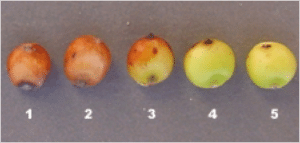Early planted sorghum is maturing and producers will need to decide soon if they want to spray a harvest product to aid in combining. A harvest aid kills the grain sorghum plant (glyphosate) or dries up leaves (sodium chlorate) and allows easier cutting where stands are thick, removes food source from heavy sugarcane aphid infestations, or is a way to clean up grasses or vines. Aim herbicide is labeled to desiccate vines in sorghum but is not an effective crop desiccant.
- Harvest aids are typically sprayed on mature sorghum 7 to 10 days before anticipated harvest date. Glyphosate treated milo can have weak stalks since the plants are essentially dead and deteriorating, especially when stalk rots are present. Timely harvest is a necessity. Sodium chlorate kills green leaves but does not immediately kill the plant and harvest can be delayed up to 10 days after treatment. PB1580 contains additional directions for timing, use rates and recommended application GPA.
- Spray harvest aid only when most of the field has exceeded physiological maturity. It is a judgement call on how long you want to wait on those late emerging heads and some late heads will need to be sacrificed to manage the majority of the mature crop. A harvest aid will not mature out a green seed.
- Mature sorghum heads will have bronze, dark orange or brown seed, depending on the cultivar. Sorghum seeds mature at the top of the head first and the bottom of the head last, similar to flowering pattern. Physiologically mature seed will be around 30% moisture (dry sorghum has moisture content of 14%) and have a ‘black layer’ which is a dark dot where the kernel attaches to the plant. Photo showing progression in maturity by color is from Texas A&M.

- Weather dictates how quickly grain heads will dry down. A moisture meter is probably the most accurate way to monitor seed moisture by sampling heads that are representative of field conditions. (Note: Seed color is another way to monitor maturity, but it can be subjective. In photo above the #1 seed is an example of a dry mature seed with hard starch while #2 is mostly mature but still contains more soft starch and would be wetter).
- Harvest sorghum at 18 to 22% moisture when heated-air drying is an option. Harvesting below 18% will mean some harvest losses, but applies when dryers are not available. Harvesting at high moistures (>22%) usually means more trash comes with the seed, and seed may need to be cleaned prior to storage.

